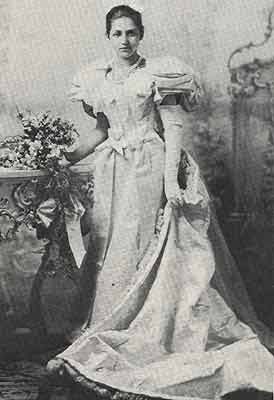

THE Princess Bamba Collection has been acquired by the' Government of Pakistan
for preservation as a national asset by the Department of Archaeology. It
belonged to Maharaja Ranjit Singh, the founder of the Sikh ruling dynasty
of the Punjab and his son Maharaja Dalip Singh. Most of its objects appear
to have originally gone out of the Sikh Darbar in Lahore to England, where
Maharaja Dalip Singh was exiled after the annexation of the Punjab by the
British in 1849. The collection remained in his Suffolk home as a family treasure,
which was later on inherited by his daughter, Princess Bamba Jindan, who died
issueless in 1957. The collection is, therefore, of immense historical significance
as it throws ample light on the life and time of Maharaja Ranjit Singh, his
son Maharaja Dalip Singh and the Sikh Darbar in Lahore. It also reveals a
distinct artistic taste of the Sikh royal princes during the turbulent period
of the mid-!9th century Punjab.
Although, Sikhism was born as a result of a great wave of spiritual awakening
during the 15th century in the areas now called West Pakistan, the growth
of Sikh political power in the Punjab and the North Western regions in the
beginning of the 19th century, deserves a critical appreciation for understanding
the implications of the regional cultures. The founder of Sikhism, Guru Nanak,
was born at a village named Talwandi (modern Nankana Sahib) near Lahore. He
preached against idolatry, caste distinction and hypocrisy, and gave his followers
a comprehensive ethical code. A close study of the events connected with the
lives of his religious successors-the Gurus-will reveal how deeply they were
associated with Pakistan. The presence of over 130 shrines dedicated to different
Gurus, situated in the length and breadth of West Pakistan, bear testimony
to their close and continuous contact with this area during the centuries
following the death of their founder.
Guru Nanak had emphasised that fundamental truth underlines all religions
and the chief features of his system were its 'non-sectarian character and
its harmony with secular life.' The early Gurus were religious preachers and
did not interfere in politics; but later on, their conflicts started with
the Mughal emperors, and after the death of Emperor Aurang-zeb, the Sikhs
under the leadership of their religious leaders over-ran the provinces of
Sirhind and Delhi. The 18th century was, thus, a period of political upheaval
in the Punjab. After Guru Gobind Singh in 1708 had entrusted the secular affairs
of the Sikhs to Lachman Das, a Hindu Pandit, who was re-named Banda Bahadur
and who returned to the Punjab from Deccan with Guru Gobind Singh's banner,
his battle drum and five arrows and spent most of his time in fighting the
Mughal forces of Emperors Bahadur Shah and Farukhsiyar. Banda Bahadur tried
to introduce certain religious innovations in the Sikh faith, but the orthodox
element headed by the wife of Guru Gobind Singh, opposed these changes. His
difference with the orthodox group of Sikhs resulted in the desertion of a
large number of his followers with the result that he suffered a defeat at
the hands of the Mughal army.
With Banda's death in 1716 the political power of the Sikhs came to a steep
decline. The religious affairs were entrusted to Bhai Mani Singh with the
backing of the faction led by the wife of Guru Gobind Singh. At the same time,
the Mughal power had also started showing signs of disintegration. The Marathas
were consolidating their position and the Jats were in open revolt around
the capital itself. The prevailing political anarchy was aggravated by the
successive invasions of Nadir Shah in 1738 and Ahmad Shah Abdali from 1748
to 1767. These invasions helped the Sikhs to establish their rule in the Punjab
over the area extending from Rawalpindi to the bank of Jamna in the east and
up to the Thar desert in the south. But the internal conflicts augmented the
different Sikh factions and hostilities of the Afghans, the Dogras, the Gurkhas,
the Marathas and the English created great obstacles in the establishment
of a stable Sikh Government.
Out of this chaos Maharaja Ranjit Singh, by dint of his chivalry and statesmanship,
consolidated a powerful kingdom on the northwest of the Sutlej, at the beginning
of the nineteenth century. This he did by strengthening both his political
and military power. The inhabitants of the Punjab, irrespective of caste or
creed, were associated with his Government. His army consisted of the Sikh,
Gurkha, Panjabi Musalrnan and Pathan soldiers. European officers, at one time,
nearly three dozen, were employed to organise and train the troops. The highly
placed foreign officers in his service were French Generals Ventura, Allard
and Court; Avitabile, an Italian, and Colonel Gardner an Irishman, who commanded
his cavalry, infantry and artillery. These officers can be seen in the painting
depicting the Darbar of Maharaja Ranjit Singh (Below)
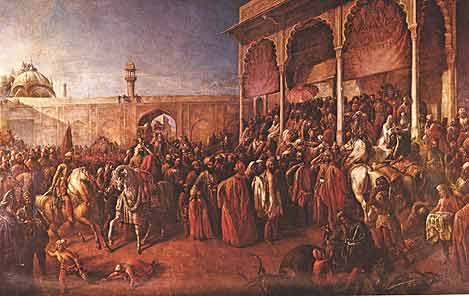 .
.
The 'Court of Lahore'. Painting in oils by August Schoefft (1809-1888), c.1850-1855,after original drawings made by the artist at lahore, 1841. Princess Bamba Collection, Lahore Fort, Pakistan.
It is very strange that none of the European officers fought
on the Sikh side in the Anglo-Sikh wars, and in fact many volunteered for
service in the English army. Canons were manufactured in Lahore and Muslim
gunners were trained to handle them. Maharaja Ranjit Singh had several able
councillors; these included Fakir Sayed Nooruddin and Fakir Sayed Aziz-ud-din.
(The Fakirs and the European officers also appear in S. No. 58).
Maharaja Ranjit Singh died in 1839 without nominating his successor. As he
had no time to found any permanent institutions, which could live apart from
him, his death was the signal for the beginning of fight for power. The Sikh
throne was successively occupied by his eldest son Maharaja Kharak Singh who
died in 1840; his grandson Maharaja Naunihal Singh (d. 1840) and his second
son Maharaja Sher Singh (d. 1843) who were all murdered one after the
other by rival factions.
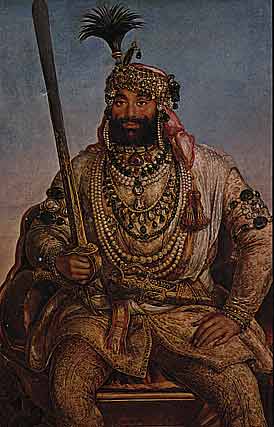
Maharaja Sher Singh (Bamba Collection)
In the year 1843, Maharaja Ranjit Singh's son Prince Dalip Singh by Rani Jindan, ascended the throne at the age of six. Rani Jindan was the daughter of Sirdar Manna Singh Aulakh of Chauganwan .
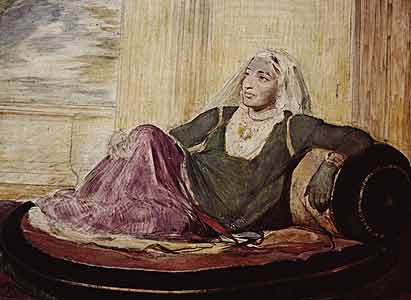
Rani Jindan (1817-1863) seated on a cushion. A sketch in oils perhaps by August Schoefft, Lahore 1841. princess Bamba Collection. Lahore Fort.
The Anglo-Sikh wars resulted in ultimate liquidation of the
Sikh power, and on 30th March, 1849, Maharaja Ranjit Singh's short-lived kingdom
was annexed by the British. Maharaja Dalip Singh was taken away to Fatehgarh
in the U.P., and put under the tutelage of Sir John Login of the Bengal Army,
with the result that after two years the young Maharaja expressed a desire
to renounce his faith and embrace Christianity. He was baptised, granted a
pension, sent to England and given an estate in Suffolk. He married Bamba
Muller, daughter of a European merchant and an Abyssinian mother. The marriage
took place in the British Consulate at Alexandria, Egypt.
Maharani Bamba spoke and understood only Arabic, and in the beginning the
Maharaja had amusing difficulties when attempting to converse with his fiancée.
She bore him Prince Victor Dalip Singh (b. 1867, d. 1918), Prince Fredrick
Dalip Singh (b. 1868, d. 1926), Princess Bamba Jindan (b. 1869, d. 1957),
Princess Katherine, Prince Albert Edward Dalip Singh (b. 1879, d. 1893) and
Princess Sophia Alexandra, (b. 1874, d. 1948).

Prince Victor Albert Dalip Singh (1867-1918)
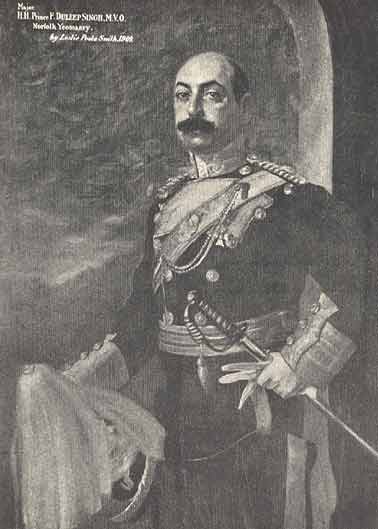
Prince Fredrick Dalip Singh (1868-1926). Princess Bamba Collection, Lahore Fort.
The children of Maharaja Dalip Singh died issueless. Dalip Singh
came to India twice and was reconverted to his paternal faith. In 1886 he
made an attempt to leave England for good and settle down in the Punjab, but
his attempt failed and he was not allowed to proceed beyond Aden. He did not
return to England and died in Paris in 1893.
Princess Bamba Jindan Dalip Singh, who later on married an English gentleman
Dr. Sutherland, continued to keep in her custody the collection of paintings
and objects of arts, belonging to her father. She died in Lahore on March
10, 1957, without having any issue and, thus, with her death ended the line
of the Sikh ruling dynasty. She bequeathed the collection to Pir Karim Bakhsh
Supra of Lahore who sold it recently to the Government of Pakistan.
The collection consists of 18 oil paintings, 14 watercolours, 22 ivory paintings,
17 photographs, 10 metallic objects and 7 miscellaneous articles.
The paintings in this collection are mostly the work of European artists,
and therefore, they do not belong to the style of painting which was in vogue
in the Punjab during the Sikh period and which resembled broadly the Kangra
School. A number of paintings of that period are in the Central Museum, Lahore.
There are also panels of wall paintings in the Samadhi of Maharaja Ranjit
Singh; in the Haveli of Maharaja Naunihal Singh in Lahore and on the walls
of the Mirs'Harem in the Hyderabad Fort. In the Lahore Fort, the Department
of Archaeology has traced a number of wall paintings of the Sikh period, which
were concealed under lime plaster of the British period. These paintings provide
interesting material for a study of the Sikh period art.
The majority of paintings of the Bamba collection are, thus, the work of European
painters: August Schoefft, Leslie Poole Smith, Goldingham, BlakeneyWard, P.C.
French, Paillet and Winterhalter, and represent the styles in vogue in Europe
in the 19th century. The painting illustrating the 'Darbar of Maharaja
Ranjit Singh' by Aug. Schoefft (above) deserves special consideration
on account of the unusually large size of the canvas, I92"xl00",
and the minute details of the Sikh Court. The scene depicts Maharaja Ranjit
Singh dressed in plain white clothes seated with all the glory of the royal
Darbar. The paintings showing "Maharaja Ranjit Singh" at Amritsar
and 'Maharaja Sher Singh in Council' give a glimpse into their unsophisticated
life.
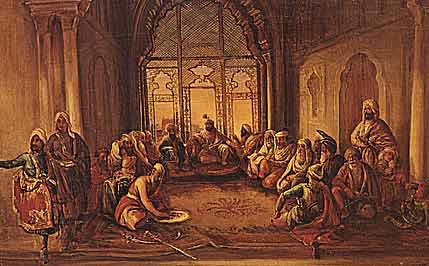
Maharaja Sher Singh (1807-1843) seated, attended by his council in the Lahore Fort. A sketch made by August Schoefft, Lahore 1841. Princess Bamba Collection.
The portraits of Maharaja Sher Singh, the Mughal Emperor Bahadur Shah and
his sons, and Maharaja Dalip Singh depict in very minute detail the richness
of the costumes and jewels worn by them.
Among the watercolours, the painting of Maharaja Dalip Singh deserves special
attention on account of its details and over-all grace and charming effect,
which it produces. It was commissioned by Queen Victoria and painted in the
Buckingham Palace by Winterhalter.
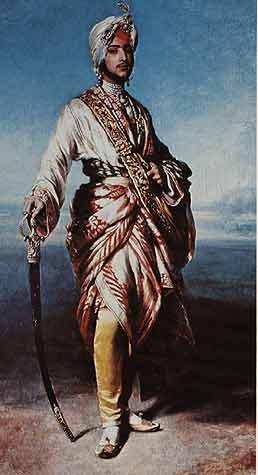
Maharaja Dalip Singh (1838-1893). Painting in oil s by Franz Winterhalter (1805-1873), London, Royal Collection, Osborn House.
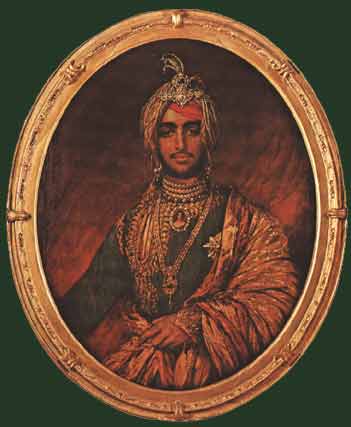
Maharaja Dalip Singh. Painting by an unknown artist. London(?),c,1863. Princess Bamba Collection, Lahore Fort.
The twenty-two oval ivory miniatures are in the style prevalent
in Delhi, Agra and Benaras in the 19th century . The photographs of Anne Dalip
Singh and the sons of Maharaja Dalip Singh are valuable historical record.
Among silver objects, the model of Maharaja Ranjit Singh riding-instate
on an elephant, (L 32" B. 23", H. 44"), is exquisitely finished.
The inscription on the silver cup presented to Princess Sophia Dalip Singh
reflects the sentiments of love and affection of the Sikhs, which they had
for their ruling family.

Maharaja Ranjit Singh on Elephant
The horse trappings set with gold and precious stones, and the gold plated umbrella give an idea of the wealth of the Sikh Court .(BELOW)


Horse Trappings of Maharaja Ranjit Singh in three pieces (1) Sar Band. (2) Seena Band and Dum Gazz (tail strap) covered with red velvet richly covered with gold decorations and studded with diamond rubies, jaspers.
The plaster cast of the marble bust of Maharaja Dalip Singh made under
orders of Queen Victoria by Baron Marochetti, is a fine specimen of statuary.
The original is in the Buckingham Palace.(Below)

Plaster cast of marble bust of Maharaja Dalip Singh at age of 18, by Baron Marochetti. The original is at Buckingham Palace and a duplicate at Blottorton Hall, Norfolk -Sophia Dalip Singh owned the present piece.
The Arzdasht in Persian, by Rai Kanahiya Lall, author of Zafar
Nama Ranjit Singh, presenting a copy of his work to Maharaja Dalip Singh,
demonstrates how the Persian language enjoyed the patronage in the Sikh
Court.
The present collection, in short, contains a number of paintings and other
miscellaneous objects which have a direct bearing on the house of Maharaja
Ranjit Singh and his son Dalip Singh, and their return from the U.K. to their
original homeland will be a valuable addition to the art treasures of Pakistan.
We are indeed very grateful to Pir Karim Bakhsh Supra whose keen interest
in the preservation for our cultural heritage and whose desire that the collection
should not go out of Pakistan, enabled us to acquire these relics.
(There are quite a number of other painting from the Princess's collection./ These are all catalogued by the Department of Archeology in Pakistan. We have been able to show only a few of these exceptional SIKH HERITAGE relics. [Kanwal] )
